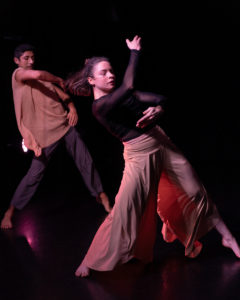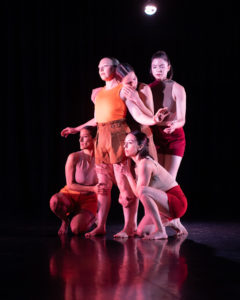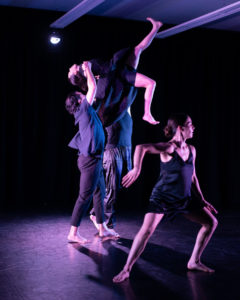A Choreography Master Class: Malashock’s Everyday Dances
Programs for performances are often forgettable (and these days, often accessed via a bar code). Happily, that’s not the case with “Everyday Dances III,” offered by Malashock Dance January 25-28. Ten choreographers set work on the company, and each offers a brief, often illuminating program note about the idea(s) they’re investigating. (The program is also visually lovely, with text set on shadowy images of dancers.)
Gina Bolles Sorensen and Kyle Sorensen share that they begin with “a single image and a few questions. Image: a path. Questions: How and why do we help each other along? … hold each other back?” Their mesmerizing “On Going” gleams with choreographic intelligence, as two pairs of dancers do diagonal steps to a slow but insistent rhythm—the Romanian classic “Pana Cand Nu Te Iubeam” recorded by Pink Martini.

Nick McGhee and Lauren Christie. Photo: Doug McMinimy
Lauren Christie and Nick McGhee weave in a sensual duet, while Natalia Hill and Chelsea Zeffiro crawl. One dancer grasps another’s ankle … or head. And there’s a fey gesture like rabbit paws, in this piece that offers ongoing pleasures.
Like a master class in choreography, much of the work in this strong program showed that kind of clarity of intention.
John Malashock, who founded the company in 1988, has stepped back as artistic director; in January, he passed the role to Christopher Kaui Morgan. But Malashock is still making work. His “Pointed Conversations” is a suite of three gestural conversations, set to an original guitar score composed and performed live by Rann Golamco.
To urgent opening chords, Christie, Hill, and Zeffiro cluster, wrists fluttering; one initiates a movement while the others watch intently, then respond. Jessica Rabanzo-Flores and Micah Parra ply graceful arms and swinging legs as if sculpting space to a lyrical part of Golamco’s score. And the four company men show off their power with runs and sideways leaps, in what I hope will become a full-length piece.

“she is what she is and she is whole.” Photo: Doug McMinimy
Golamco also composed and played live for Rabanzo-Flores’s “she is what she is and she is whole.” In this vibrant exploration of the wild woman archetype, five women (including the riveting, supple-spined Rabanzo-Flores) stake out territory yet offer mutual support. Deep pliés suggest a sumo wrestler or giving birth. When they look at the audience, their uncompromising gazes say, “I don’t care what you think of me.”
Gary Champi has a degree in cognitive science, and in his “Reset,” four dancers cluster and disperse as if demonstrating flocking behavior. They begin in their own world—in a line at the rear of the stage, their backs to us. They shift position, rearrange their order. Breaking out of the line, they play with speed and balance—slowly extending a standing leg, or scrambling with frenetic limbs.
Matthew Armstrong and Micah Parra make wary eye contact in “Water and Sand” by Khamla Somphanh. And no wonder. In this intense, risky partnership, they scramble and roll, and do roundhouse kicks over each other’s heads. Then, like the sea hugging the shore, they join—Armstrong lifting Parra, she jackknifing her body over his head, both going into turns with open, breathy arms.

“Sushi in Bed.” Photo: Doug McMinimy
The expressive Parra does flirtatious partnering in “Sushi in Bed,” a look at relationships by Viviana Alcazar. Although the four dancers (Parra, Rabanzo-Flores, Joey Lister, and Marshall Whiteley) pair off in various combinations, Parra and Whiteley have such great chemistry, it reminded me of two City Ballet dancers whom I wrote looked ready to run away with each other; they ended up getting married! Whiteley is a striking addition to the company; a veteran of American Ballet Theater, he combines power and ease. And he looks like he’s having a blast.
Megan Curet’s smart, engaging “Cuerpos Sin Fronteras,” calls attention to the body in space. Four dancers in striped shirts, wearing backpacks, form a line, then break out in a sideways step-fall. They extend perpendicular arms and manipulate each other’s position. At times, one takes off the backpack, removes a few items—always including a book—then replaces them. I wanted to know what they were reading!
A few pieces felt less developed. “Us Reassembling or Landscape in Drift” by Chelsea Zeffiro looks fun to do—three dancers often join in an organic blob, and whose foot is that?—but uninvolving to watch. Matthew Armstrong’s “Triple Take” showcases his rangy form as he reaches and rolls, with Christie and Hill crawling over him, yet the piece feels muddy.
“1-800-luv4sale(&commercialbreaks)” by sol dela rosa had the wildest costumes: white bodysuits splashed with bright orange like, maybe the muscular system? In the program, dela rosa writes about the power of play, and the piece looks like three dancers at play, with strutting to club music and a droll bit where McGhee lip-synchs to a woman’s voice. I missed any sense of choreographic shaping in this piece.
An earlier iteration of “Everyday Dances” struck me as too slight. This time around, the work was anything but everyday.

Award-winning dance journalist Janice Steinberg has published more than 400 articles in the San Diego Union-Tribune, Dance Magazine, the Los Angeles Times, and elsewhere. She was a 2004 New York Times-National Endowment for the Arts fellow at the Institute for Dance Criticism and has taught dance criticism at San Diego State University. She is also a novelist, author of The Tin Horse (Random House, 2013). For why she’s passionate about dance, see this article on her web site, The Tin Horse

Wonderful photography.
Dear Janice:
So glad that you are back. The dance community needs your critical voice.
Thank you,
George
Thank you for sharing your review with our community!